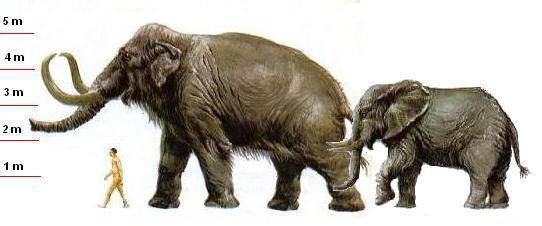| New Photos | Animal News | Animal Sounds | Animal Movies | Upload Photo | Copyright | Korean |
|---|
| Funny Animal Photos | Monsters in Animalia | Wiki Articles Fun Facts about Animals | Links | Home | Mobile A.P.A. |
|---|
| Image Info | Original File Name: Shokado or Songhua River Mammoth, Mammuthus-sungari, comparison with man and African elephant.jpg Resolution: 542x226 File Size: 53703 Bytes Upload Time: 2008:01:14 13:08:37 | |
| Author | Name (E-mail): Unknown | |
| Subject | Songhua River Mammoth (Mammuthus sungari) - Wiki | |
 |
| Email : E-Card | Poster | Web Master Delete Edit Info Admin |
| Description | Songhua River Mammoth (Mammuthus sungari) - Wiki
Mammuthus sungari
According to the Ibaraki Nature museum, the Songhua River Mammoth -- also known as the Shokako Mammoth in Japanese -- (Mammuthus sungari) was the largest mammoth in the world, surpassing even the Imperial Mammoth in size. The mounted skeleton at the museum reaches an overall height of 5.3 meters and a length of 9.1 meters, with hips more than 2.2 meters wide and tusks 3.2 meters in length. This specimen could have weighed more than 17 metric tons, as heavy as Paraceratherium, making it one of the largest land mammals of all time. The Songhua River Mammoth lived in Northern China during the Late Pleistocene about 100,000 to 10,000 years ago. Its remains have been found in the Gobi Desert. Size Asier Larramendi and P??rez Molina estimated that a Songhua River Mammoth 4.7 meters high at the shoulders would have weighed more than 17 metric tons, or nearly three times heavier than the modern African elephant. Method of estimation To calculate the mammoth's weight, Asier Larramendi created a technique (based on Gregory Paul´s drawings) that consisted of separating the animal into different parts and modeling those parts as cylinders. The volumes of these cylinders can then be calculated and multiplied by the typical density of mammals. To demonstrate the accuracy of the technique, the approach was applied to an African elephant 3.5 meters high. The estimated weight for this animal was found to be 6.4 metric tons, which is consistent with the actual weight of an elephant of that height. Comparison to other large mammals Larramendi applied his model to a 4.5 meters tall Mammuthus trogontherii, getting the result of 12 metric tons. The much smaller figure owes to the fact that M.sungari was nearly a third wider than M.trogontherii. Larramendi then applied the same approach to estimate the mass of the largest Indricotherium found, which was 5.4 meters to the shoulders. The Indricotherium was estimated to weigh 16.8 metric tons, about a half ton less than the M.sungari, due to its more slender frame. If accurate, this would imply that M.sungari was the largest land mammal known to have lived. Paleontologist Gregory Paul has estimated that the largest Indricotherium remains found (two giant vertebrae and a partial central metacarpal) suggest the a height at the shoulders of 4.8 meters. Nevertheless, Paul estimated the mass of the Indricotherium at over 16 metric tons. Larramendi's approach would result in the lower estimate of 14.5 metric tons for this animal. For the mammoths' calculations there would be significant differences as well; Paul estimated a 4.0 meters M.Trogontherii would weigh 11 metric tons, while Larramendi estimated 9 metric tons. http://en.wikipedia.org/wiki/Mammuthus_sungari
| |||
| Comments |
| |||||||||||||
| Copyright Info | AnimmalPicturesArchive.com does not have the copyright for this image. This photograph or artwork is copyright by the photographer or the original artist. If you are to use this photograph, please contact the copyright owner or the poster. |
|
|
|
| |||||||
| CopyLeft © since 1995, Animal Pictures Archive. All rights may be reserved. | ||||||||
Stats